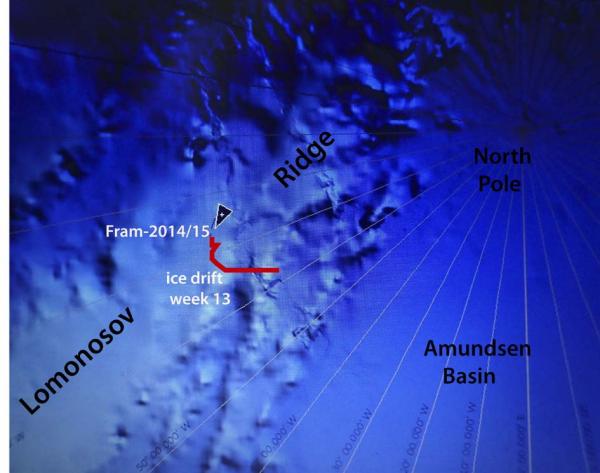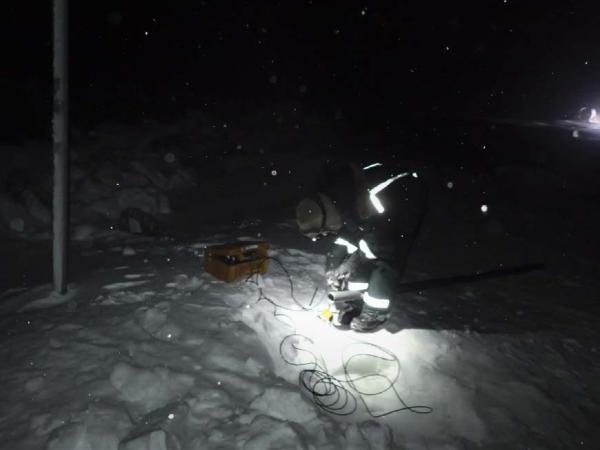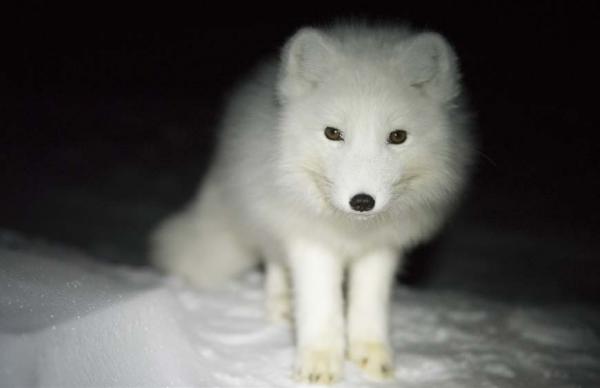
(24 Nov.- 01 Dec. 2014)
Ice drift
The ice camp moved about 28 nautical miles (52 km) during the week (Fig. 1). The ice drift was for the most part towards the west and brought us over and along the top of Lomonosov Ridge. An elongated and strong high pressure cell extended from Novaja Zemlja to past the New Siberian islands during the first part of the week, but from Thursday on the surface air pressure gradients were weak over the entire Arctic Ocean. We experienced a short period of strong winds late Tuesday and early Wednesday morning with gust over 40 knots due to a low pressure trough extending north from the Fram Strait. During this event the ice drift increased from 0.1 knots to 0.5 knots.

Fig. 1 Drift track of FRAM-2014/15 over Lomonosov Ridge during week 13
Sea ice dynamics
There has been some minor divergence and shear motion in the main deformation zone through our abandoned camp area. We searched the neighborhood for a site and decided to establish the new camp about 300 meters away from where the bulk of our supplies are currently located. We have no illusions about this location being better than any other, but the area surrounded by "old" pressure ridges appears relatively free of small incipient cracks and the distance to a large lead is over 200-300 meter. We will use the light from the next full moon to further explore the area.
Camp life
Temperatures were below - 30° C on Monday and Tuesday, but later between - 23° C and - 14° C except Thursday (- 30° C). It is clear that the effort required to complete the recovery of all the different pieces of supplies from the abandoned camp was far more exhaustive than we initially thought. Two weeks have now passed since the camp was disrupted, and we are not anywhere near the point where we are up and going again. We still have no hydro hole through the ice, new work space still needs to be made and supplies to be moved. The locations of the two current meters and the thermistor string seem unharmed, but the radiation flux instrument and the weather station will be moved. The priority is moving fuel and food towards the new site.
Science
This week, the following suite of continuous measurements has been unaffected by the ice activity:
Bathymetry and sub-bottom profiling:
- two active autonomous echo sounder buoys reporting to shore via Iridium
Oceanography:
- two Aanderaa current meters at 800 and 1050 meter depth, respectively.
- thermistor string with 30 thermistors from the surface to 300 meter depth.
Atmosphere:
- Aanderaa weather station (wind, temperature and humidity)
The destruction of our camp area, made it unrealistic to carry out any additional science tasks during the week.
We tried to recover the Acoustic Doppler Current Profiler by drilling a hole 2 meter away from the line were it was attached (Fig. 2). At 4 meter depth, the length of our drill, we had still not penetrated the stack of multiple ice layers. We made another hole 7 meters away through 2 meter thick ice and lowered a camera, but were not able to spot any sign of the ADCP. The visibility in the water was very poor from ice crystals in suspension.
Our new visitor has made him/herself familiar with a new and easy access to food. The animal is more confident and frequently comes to within a few meter of our activity (Fig. 3). Early on, Audun discovered droppings which have been taken care of to be handed over to people who can investigate the diet of a polar fox roaming in the central Arctic Ocean. Our friend needs a name an suggestions so far are; Slikkepott, Mikkel or Putin.

Fig. 2. The ADCP site marked with a pole. We are making the camera ready to be lowered. Note the front of the pressure ridge in the background.

Fig. 3. The polar fox, our companion on the ice near the North Pole.
Life is treating us well.
Yngve Kristoffersen & Audun Tholfsen
Daily reports
Monday 24 November.
Position: 88° 45.3' N, 59° 07' W, temperature - 32° C, air pressure 1008 hPa, wind 13 knots from NNW. Ice drift 0.2 knots towards south. The generator would not start and repair took all morning. Continued to haul equipment out of the demolished storage area and move fuel by pumping. Rescued the large 14 m x 9 m tarp from the remains of the ice hangar.
Tuesday 25 November..
Position: 8° 44,0' N, 58° 22' W, temperature - 34° C, air pressure 1016 hPa, wind 7 knots from the E. Ice drift 0.1 knots towards west. Recovered the radiation flux instruments and moved three loads of equipment from our abandoned hydro hole. A 15 cm wide crack had opened right through the hole.
Wednesday 26 November.
Position: 88° 40.8' N, 63° 31' W, temperature - 18° C, air pressure 995 hPa, wind 28 knots from ESE. Ice drift 0.3 knots towards west. The strong wind with gust up to 40 knots had created snow drifts around the hovercraft and filled the lift fan intake completely. Dismantled the work space around the abandoned hydro hole and moved the materials to the temporary storage area. Mobilized the hovercraft to move to a better site, but could not achieve sufficient rpm's. Need advice to tackle the problem.
Thursday 27 November
Position: 88° 41.5' N, 64° 21' W, temperature - 30° C, air pressure 1008 hPa, wind 10 knots from ENE. Ice drift 0.2 knots toward south. Attempted to recover the ADCP. Drilled a hole 2 meter away from the wire to 4 meter depth which was the maximum length of our drill. Hit several layers of ice with water in between, but unable to reach all the way through. Drilled a second hole 7 meters away through 2 meter thick ice. Lowered a camera, but unable to see the ADCP on the monitor. The visibility in the water was poor due to large quantities of ice crystals in suspension. We will revisit the site later to see if the instruments could show up in a pressure ridge and be recovered. At this point, we have to accept the loss.
Friday 28 November.
Position: 88° 35.8' N, 64° 52' W, temperature - 14° C, air pressure 995 hPa, wind 12 knots from NE. Ice drift 0.3 knots towards south. Had problems with getting the hovercraft engine to respond to the throttle position. Consulted Griffon Hoverwork. Problem was a loose wire and also in the end a parted pipe connection to the intercooler. Moved the hovercraft to a site 300 meter away where the new camp will be. To bed at 0330 hours.
Saturday 29 November.
Position: 88° 32.7' N, 66° 07' W, temperature - 21° C, air pressure 1016 hPa, wind 13 knots from SE. Ice drift 0.1 knots towards west. Demobilized the hovercraft.
Sunday 30 November.
Position: 88° 33.5' N, 70° 59' W, temperature - 23° C, air pressure 1017 hPa, wind 10 knots from S. Ice drift 0.1 knot towards northeast. Made a ski sled and moved the generator and some materials to the new site. Put up a new generator shed.

